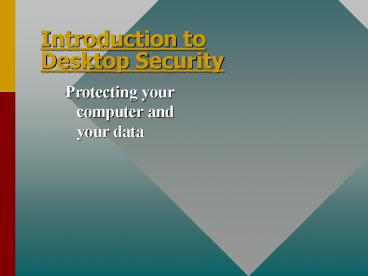Introduction to Desktop Security PowerPoint PPT Presentation
Title: Introduction to Desktop Security
1
Introduction to Desktop Security
- Protecting your computer and your data
2
Malware The Threats
- Viruses
- Worms
- Spyware/Adware
- Phishing
3
Viruses
- Usually come in email
- Have to be run
- Trick you into running the virus
4
Worms
- self-replicating computer program
- Looking for you
- Exploiting Weaknesses
- Install Back Door or other malware
5
Spyware
- Comes from other software
- Tracks usage
6
Phishing
- Social-engineering schemes use 'spoofed' e-mails
to lead consumers to counterfeit websites
designed to trick recipients into divulging
financial data such as credit card numbers,
account usernames, passwords and social security
numbers. - vishing variation
- www.antiphishing.org
7
Phishing
- Deceptive Subject Line
- Apparent genuine content
- Forged Senders Address
- Disguised Links
- Email Form
8
Possible Problems
- Trojan Horses
- Zombie your Computer
- Destroy Data
- Steal Data
- Key Loggers
9
Software Protections
- System Updates
- Anti-Virus software
- Anti-Spyware Software
- Firewall
10
Anti-Virus
- Keep up-to-date
- Scan daily
- Check Files in use
- AVG from grisoft.com
11
Anti-Spyware
- Update regularly
- Scan regularly
- AdAware from Download.com
12
Firewall
- Guards information flowing to and from your
computer - ZoneAlarm from zonelabs.com
13
Safe Computing Practices
- Update the Operating System
- Keep protections updated
- Scan Regularly
14
Safe Computing Practices
- Regularly Back-up needed files
- Dont download files using P2P
- Only get upgrades from trusted sources
- Use an alternate browser such as FireFox or Chrome
15
Safe Computing Practices - email
- Dont open attachments even when they are from a
trusted source - Dont unsubscribe to spam
- Dont click on links in emails
16
Safe Computing Practices - Data
- Dont give out information especially your SSN
- Banks and credit card companies never use email
to confirm data - Check for secure sites when shopping (https)
- Use a separate credit card and check each months
bill
17
Learn More
- CIS 115 Information Security
PowerShow.com is a leading presentation sharing website. It has millions of presentations already uploaded and available with 1,000s more being uploaded by its users every day. Whatever your area of interest, here you’ll be able to find and view presentations you’ll love and possibly download. And, best of all, it is completely free and easy to use.
You might even have a presentation you’d like to share with others. If so, just upload it to PowerShow.com. We’ll convert it to an HTML5 slideshow that includes all the media types you’ve already added: audio, video, music, pictures, animations and transition effects. Then you can share it with your target audience as well as PowerShow.com’s millions of monthly visitors. And, again, it’s all free.
About the Developers
PowerShow.com is brought to you by CrystalGraphics, the award-winning developer and market-leading publisher of rich-media enhancement products for presentations. Our product offerings include millions of PowerPoint templates, diagrams, animated 3D characters and more.

